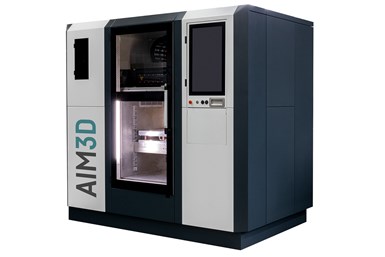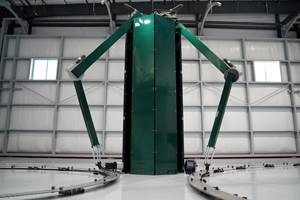AIM3D Study Shows 3D Printing Ultem 9085 Pellets Offers Lower Cost, Higher Tensile Strength
The material qualification testing indicates many benefits of creating components with AIM3D’s ExAM 510 printer using the composite extrusion modeling process, which uses standard pellets rather than the more expensive filaments required by other platforms.
AIM3D says its material qualification testing of Sabic’s Ultem 9085 resin granulate for its ExAM 510 3D printer using its composite extrusion modeling (CEM) process with standard pellets showed a variety of benefits compared to using filament 3D printers. The advantages include lower material costs, faster build speeds, improved reproducibility and high tensile strengths, which can open up new fields of application for using 3D pellet printing of Ultem without filaments.
As part of the material qualification process, AIM3D analyzed the properties of a component printed using Ultem 9085 resin on its ExAM 510 3D printer to unlock its use in pellet 3D printing. The company’s CEM process uses standard pellets and thus offers a high potential of economic efficiency and higher build speeds compared to filament 3D printers.
The objective was to take advantage of the significantly lower material costs when using standard granulates compared to using conventional filament materials, which are said to be reduced by up to a factor of seven. The development focused on high-performance applications in the aerospace sector.
Sabic’s Ultem 9085 resin is a certified material in the aerospace industry (FAR 25.853, Blue Card and UL 94 V-0) with special fire safety qualities. As a member of the polyetherimide (PEI) family, it is a high-temperature material with excellent physical and mechanical properties for demanding applications. Due to its strength-to-weight ratio, Ultem is considered an ideal thermoplastic for applications that require high strengths and a low weight.
In general, Ultem 9085 resin also exhibits a high impact strength and very good chemical tolerance, showing very good flammability, smoke and toxicity properties. Sabic supplies Ultem 9085 resin in many different colors and can be customized to any color requirements.
The results of tensile strength testing indicate comparable results with injection molding and much better results than filament 3D printing. It was also found that the elongation at break of the specimens printed using granulates provided significantly better results — 12.3% elongation at break could be achieved in the XY direction, while filament 3D printing only reaches 5.4%.
Testing also indicates improved reproducibility with a 3D pellet printer. Components created using both injection molding technology and 3D pellet printing exhibited comparable homogeneities of the material due to the use of Ultem 9085 resin granulates. The latest tensile tests according to DIN EN ISO 527-2 type 1A presented low standard deviations and prove the high stability of the process.
Pellet printing offers significantly faster time-to-market, both for prototypes and for series components. AIM3D’s extruders and technology also achieve better surface qualities with the same build time. This is possible because the use of granulates enables higher build rates to be achieved even with lower layer thicknesses.
“The use of a pellet 3D printer will not only make existing applications more cost-effective in the future,” says Dr. Vincent Morrison, AIM3D CEO. “In fact, we will see a much wider application of Ultem 9085 resin in the future, with fields of application that simply were not economical in the past. Especially in the aerospace sector, this will open up new horizons.”
- Read about the research partners that 3D printed a MIM tool with near-contour cooling. The basis of the project was the use of AIM3D’s CEM technology with an ExAM 255 system, which is an all-in-one, multimaterial 3D printer for AM of metals, plastics and ceramics.
Related Content
8 Cool Parts From RAPID+TCT 2022: The Cool Parts Show #46
AM parts for applications from automotive to aircraft to furniture, in materials including ceramic, foam, metal and copper-coated polymer.
Read MoreHow Norsk Titanium Is Scaling Up AM Production — and Employment — in New York State
New opportunities for part production via the company’s forging-like additive process are coming from the aerospace industry as well as a different sector, the semiconductor industry.
Read MoreThis Drone Bird with 3D Printed Parts Mimics a Peregrine Falcon: The Cool Parts Show #66
The Drone Bird Company has developed aircraft that mimic birds of prey to scare off problem birds. The drones feature 3D printed fuselages made by Parts on Demand from ALM materials.
Read More“Mantis” AM System for Spacecraft Uses Induction for Deposition
The metal 3D printing system melts wire without lasers. 30-foot-diameter parts are built on a rotary-feed system that eliminates the need for a large machine frame or gantry.
Read MoreRead Next
Looking to Secure the Supply Chain for Castings? Don't Overlook 3D Printed Sand Cores and Molds
Concerns about casting lead times and costs have many OEMs looking to 3D print parts directly in metal. But don’t overlook the advantages of 3D printed sand cores and molds applied for conventional metal casting, says Humtown leader.
Read More3D Printing Brings Sustainability, Accessibility to Glass Manufacturing
Australian startup Maple Glass Printing has developed a process for extruding glass into artwork, lab implements and architectural elements. Along the way, the company has also found more efficient ways of recycling this material.
Read MoreGE Additive Rebrands as Colibrium Additive
As part of the brand name transition, both the Concept Laser and Arcam EBM legacy brands will be retired.
Read More











.png;maxWidth=300;quality=90)












